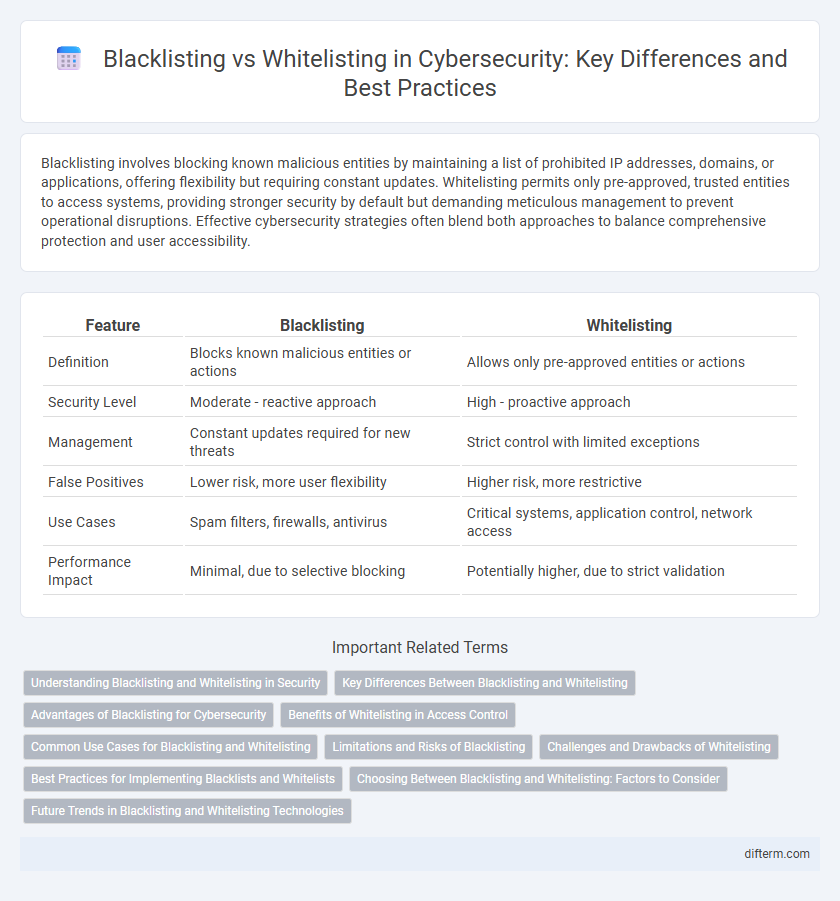Blacklisting involves blocking known malicious entities by maintaining a list of prohibited IP addresses, domains, or applications, offering flexibility but requiring constant updates. Whitelisting permits only pre-approved, trusted entities to access systems, providing stronger security by default but demanding meticulous management to prevent operational disruptions. Effective cybersecurity strategies often blend both approaches to balance comprehensive protection and user accessibility.
Table of Comparison
| Feature | Blacklisting | Whitelisting |
|---|---|---|
| Definition | Blocks known malicious entities or actions | Allows only pre-approved entities or actions |
| Security Level | Moderate - reactive approach | High - proactive approach |
| Management | Constant updates required for new threats | Strict control with limited exceptions |
| False Positives | Lower risk, more user flexibility | Higher risk, more restrictive |
| Use Cases | Spam filters, firewalls, antivirus | Critical systems, application control, network access |
| Performance Impact | Minimal, due to selective blocking | Potentially higher, due to strict validation |
Understanding Blacklisting and Whitelisting in Security
Blacklisting in security involves creating a list of known threats or unauthorized entities to block access, effectively preventing harmful actions by denying entry to specified items. Whitelisting adopts the opposite approach by allowing only pre-approved, trusted applications, users, or IP addresses to access the system, minimizing exposure to unknown risks. Understanding these methods is crucial for implementing robust access control strategies that balance security and usability in network environments.
Key Differences Between Blacklisting and Whitelisting
Blacklisting blocks known malicious entities by maintaining a list of prohibited IPs, domains, or applications, allowing all others by default, while whitelisting permits access only to pre-approved entities, blocking all others by default. Blacklisting is reactive, relying on identifying threats after they emerge, whereas whitelisting is proactive, preventing unauthorized access from unknown or unverified sources. Security policies leverage blacklists for broad threat detection and whitelists for tightly controlled environments where minimizing risk is critical.
Advantages of Blacklisting for Cybersecurity
Blacklisting enhances cybersecurity by providing a flexible approach to blocking known malicious IP addresses, domains, and applications, allowing legitimate traffic to flow without interruption. It accelerates response times by quickly updating threat databases with newly identified threats, reducing exposure to cyberattacks. Blacklisting also simplifies management in environments with diverse and dynamic user activity, minimizing disruptions while maintaining robust protection against evolving threats.
Benefits of Whitelisting in Access Control
Whitelisting in access control enhances security by allowing only pre-approved applications and users, significantly reducing the risk of malware and unauthorized access. It offers precise control over system permissions, minimizing exposure to vulnerabilities compared to blacklisting's broader, reactive approach. This proactive strategy ensures critical assets remain protected by enforcing strict, vetted access policies.
Common Use Cases for Blacklisting and Whitelisting
Blacklisting is commonly used in email filtering to block known spam sources and in firewall configurations to prevent access to malicious IP addresses. Whitelisting is frequently employed in application control by allowing only pre-approved software to run and in network security by permitting access solely to trusted devices. Both techniques enhance security by regulating access, with blacklisting targeting known threats and whitelisting focusing on trusted entities.
Limitations and Risks of Blacklisting
Blacklisting relies on identifying and blocking known threats, leaving systems vulnerable to new or unknown malware variants that bypass predefined lists. This reactive approach often results in delayed threat mitigation and increased exposure to zero-day attacks. Moreover, frequent updates and maintenance of blacklist databases demand significant resources, while false negatives can lead to security breaches.
Challenges and Drawbacks of Whitelisting
Whitelisting in security faces challenges such as the complexity of maintaining an up-to-date list of approved applications and the risk of impeding productivity when legitimate software is inadvertently blocked. The inflexibility of whitelisting can slow down deployment of new tools and requires significant administrative overhead. Moreover, sophisticated malware may exploit approved applications, bypassing whitelisting defenses and creating hidden vulnerabilities.
Best Practices for Implementing Blacklists and Whitelists
Implementing blacklists and whitelists requires precise definition of trusted and untrusted entities to minimize false positives and negatives in cybersecurity measures. Employing dynamic updates based on real-time threat intelligence enhances the effectiveness of blacklists, while maintaining comprehensive validation processes ensures whitelist accuracy. Combining both lists with layered security approaches improves overall threat detection and system resilience.
Choosing Between Blacklisting and Whitelisting: Factors to Consider
Choosing between blacklisting and whitelisting depends on the organization's security needs, risk tolerance, and resource availability. Blacklisting allows broader access with specific restrictions, making it suitable for dynamic environments requiring flexibility, while whitelisting blocks all except pre-approved entities, offering stronger security at the cost of potential operational delays. Factors such as ease of management, the criticality of assets, and threat landscape should guide the decision to implement either strategy effectively.
Future Trends in Blacklisting and Whitelisting Technologies
Advancements in artificial intelligence and machine learning are driving the evolution of blacklisting and whitelisting technologies, enabling more dynamic and adaptive threat detection. Future trends indicate a shift towards behavior-based whitelisting, where applications are continuously monitored for anomalies rather than relying solely on predefined lists. Enhanced integration with cloud-based threat intelligence platforms will provide real-time updates, improving the accuracy and responsiveness of both blacklisting and whitelisting mechanisms in cybersecurity frameworks.
Blacklisting vs Whitelisting Infographic

 difterm.com
difterm.com